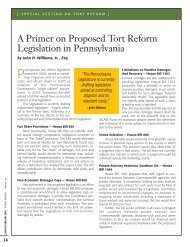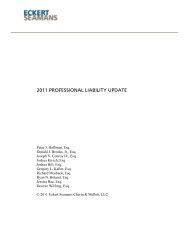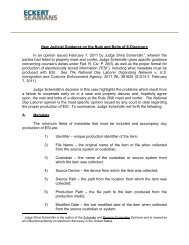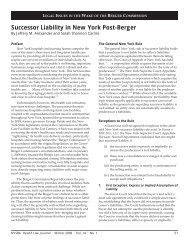Even more recently, our Superior Court held that the doctrine of corporate negligenceapplies to nursing homes. In Scampone v. Grane Healthcare Co., 2010 PA Super 124, 2010 Pa.Super. LEXIS 1486 (Pa. Super. Ct. 2010), reargument denied, 2010 Pa. Super. LEXIS 3250 (Pa.Super. Ct. Sept. 24, 2010), a decedent’s executor brought suit for the allegedly inadequate carereceived by the decedent at a nursing home facility. The Superior Court reasoned that nursinghomes are sufficiently akin to hospitals, to support the application of the doctrine of corporatenegligence. The Superior Court wrote:Herein, we conclude that a nursing home is analogous to a hospitalin the level of its involvement in a patient’s overall health care.Except for the hiring of doctors, a nursing home providescomprehensive and continual physical care for its patients. Anursing home is akin to a hospital rather than a physician’s office,and the doctrine of corporate liability was appropriately applied inthis case. Plaintiff’s decedent was a full-time resident of thenursing home, and with the exception of occasional visits from herown doctor, Highland oversaw her care twenty-four hours a day,seven days a week. In addition, whenever a patient entered thefacility, a Highland nurse assessed the patient and developed theappropriate health care plan for that patient, includingrehabilitative services. Highland was responsible for coordinatingnearly all of the health care of its patients. Even though Highlanddid not have staff physicians, it was responsible for ensuring thatall doctor-ordered testing was performed. Clearly, the degree ofinvolvement in the care of patients of skilled nursing homefacilities is markedly similar to that of a hospital and bears littleresemblance to the sporadic care offered on an out-patient basis ina physician’s office. Hence, we hold that the trial court correctlyconcluded a nursing home could be found liable under a corporatenegligence theory.Id., 2010 Pa. Super. LEXIS 1486 at *21. The Court also reversed the grant of non-suit againstthe management company of the nursing home, finding that it too, could be held liable under thedoctrine of corporate negligence. Id., 2010 Pa. Super. LEXIS 1486 at *71 (“Grane is alsosubject to corporate liability for the understaffing based upon the extent of its corporate controlover Highland”). Moreover, it is of interest to note that the Superior Court found that a corporatenegligence claim can be based on inadequate staffing levels. Id. at *22 (“If a health careprovider fails to hire adequate staff to perform the functions necessary to properly administer to apatient’s needs, it has not enforced adequate policies to ensure quality care.”).(d)HMO LiabilityIn Shannon v. McNulty, 718 A.2d 828 (Pa. Super. Ct. 1998), the Superior Courtconsidered whether the corporate negligence doctrine extends to a Health MaintenanceOrganization (“HMO”). In Shannon, Plaintiffs alleged negligence against an obstetrician forfailing to diagnose and treat signs of pre-term labor. Plaintiffs asserted two grounds of liabilityagainst their HMO: 1) vicarious liability for the negligence of its nursing staff in failing to74
espond properly to Plaintiff-Wife’s complaints; and 2) corporate liability for both negligentsupervision of the obstetrician’s care and lack of appropriate procedures and protocols whendispensing “telephonic medical advice” to subscribers.The Court held that the doctrine of corporate liability should extend to HMOs. Central tothe Shannon court’s conclusion was its finding that HMOs, like hospitals, “play central role[s] inthe total health care” of their patients. Id. at 835 (quoting Thompson,591 A. 2d at 708). Thecourt reasoned that the Plaintiff was limited in her health care choices by the HMO, whichrequired her to call either her obstetrician or the HMO’s emergency line (staffed by the HMO’striage nurses) before receiving medical care. Id. Because HMO subscribers are “given little orno say so in the stewardship of their care,” and because HMO’s “involve themselves daily indecisions affecting their subscriber’s medical care,” the Superior Court held that Thompson’scorporate liability duties should “be equally applied to an HMO when that HMO is performingthe same or similar functions as a hospital.” Id. at 836.(e)Extension of Corporate LiabilityIn Milliner v. DiGuglielmo, No. 08-4905, 2011 WL 2357824 (E.D. Pa. June 8, 2011),a prison inmate fell from the top bunk of his cell, resulting in extreme pain throughout hisbody, including his lower back. An MRI eventually revealed “several cervical discherniations, protrusions, and bulges as well as significant compression of the cervical spinalcord and possible edema on an myleomalacia of the cord itself.” Id. at *1. Plaintiffunderwent a surgery at an outside hospital, which left him immediately paralyzed from theneck down, though some movement was eventually regained in other parts of his body.Following the surgery, plaintiff received poor care and submitted numerous complaints tothe prison administrators.Plaintiff eventually filed suit against the doctor who performed the surgery, thehospital at which the surgery was performed, and various other “medical defendants” whoworked at the correctional facility. Plaintiff also filed suit against Prison Health Services,Inc. (“PHS”), a “Delaware corporation [that] contracted with the [Pennsylvania]Department of Corrections to provide health care services to inmates on behalf of theDepartment of Corrections.” Id. at *6. Plaintiff alleged corporate liability on the part ofPHS, amongst other claims.PHS filed a motion to dismiss the corporate negligence claim, arguing that it couldnot be held liable under the theory of corporate liability because the Thompson rule waslimited to entities that play a central role in a patient’s total health care. The Courtdisagreed and denied the motion to dismiss, noting that the plaintiff had sufficiently allegedthat PHS was involved with the inmates’ care to such a degree that it did play a “centralrole” in their care. Moreover, the Court cited prior Eastern District caselaw, i.e., Wheelerv. Prison Health Servs., Inc., No. 09-410, 2010 WL 3489405 at *7 (E.D. Pa. 2010), for theproposition that the Pennsylvania Supreme Court “would extend corporate negligence toan institution responsible for an inmate’s healthcare, like PHS.”3. Peer Review Protection Act (“PRPA”)75
- Page 3 and 4:
EMTALA CASES ......................
- Page 5:
Filing an Affidavit of Non-Involvem
- Page 8 and 9:
II.PROFESSIONAL LIABILITY - AN OVER
- Page 10 and 11:
The Superior Court reversed the tri
- Page 12 and 13:
to a third party pursuant to the st
- Page 14 and 15:
After approximately five months, De
- Page 16 and 17:
learned the day after the surgery t
- Page 18 and 19:
conduct to the delay in colon cance
- Page 20 and 21:
court admitted the expert’s testi
- Page 22 and 23:
(b)(c)other reasonable causes, incl
- Page 24 and 25:
corroborated his testimony. The cou
- Page 26 and 27:
husband’s estate. Plaintiff alleg
- Page 28 and 29:
Other notable federal cases arising
- Page 30 and 31: The Superior Court found that in re
- Page 32 and 33: § 1303.512(b). The court, however,
- Page 34 and 35: In Neidig v. United States, No. 07-
- Page 36 and 37: Additionally, the Supreme Court not
- Page 38 and 39: were not indicated for her conditio
- Page 40 and 41: surgeon is the same as it would be
- Page 42 and 43: It should be noted that the Superio
- Page 44 and 45: Finally, the court held that the tr
- Page 46 and 47: The Supreme Court of Pennsylvania r
- Page 48 and 49: nurses deviating from applicable st
- Page 50 and 51: certainty, the court reviews expert
- Page 52 and 53: Under Pennsylvania law, the Court n
- Page 54 and 55: testimony, Defendant presented his
- Page 56 and 57: Following Cooper v. Roberts, 286 A.
- Page 58 and 59: Plaintiff developed chronic diarrhe
- Page 60 and 61: where payment is made by Medicaid w
- Page 62 and 63: accomplished. In Valles v. Albert E
- Page 64 and 65: In 1980, the Pennsylvania Superior
- Page 66 and 67: Plaintiff had a routine monitoring
- Page 68 and 69: Plaintiff’s Contract ClaimsThe Co
- Page 70 and 71: is a failure to report changes in a
- Page 72 and 73: unit to assure post-surgical patien
- Page 74 and 75: sliced his wrist and arm with a raz
- Page 76 and 77: licensed professionals for whom the
- Page 78 and 79: (c)Limitations of Corporate Neglige
- Page 82 and 83: (a)HMO IssuesIn McClellan v. Health
- Page 84 and 85: affidavit submitted by Defendants o
- Page 86 and 87: treatments while at VA’s faciliti
- Page 88 and 89: [s]ubstantively, we believe that a
- Page 90 and 91: The party claiming the benefit of t
- Page 92 and 93: deprive (him) of civil rights guara
- Page 94 and 95: found that the District Court was w
- Page 96 and 97: With respect to fraudulent concealm
- Page 98 and 99: would be applied in situations wher
- Page 100 and 101: they had not raised them in the cou
- Page 102 and 103: (a)Informed ConsentUnder MCARE, a p
- Page 104 and 105: civil enforcement provisions and ma
- Page 106 and 107: MCARE also changes the manner in wh
- Page 108 and 109: whose death, in 2005, was allegedly
- Page 110 and 111: vicariously liable if the plaintiff
- Page 112 and 113: health center or its equivalent or
- Page 114 and 115: In Pennsylvania Medical Society, th
- Page 116 and 117: to any professional who is alleged
- Page 118 and 119: Since the 2005 amendments, there ha
- Page 120 and 121: ule, but who intentionally ignores
- Page 122 and 123: the original Complaint was delivere
- Page 124 and 125: foreclose all challenges against th
- Page 126 and 127: number of boxes), which was support
- Page 128 and 129: questions of professional judgment
- Page 130 and 131:
deviated from any professional stan
- Page 132 and 133:
The Third Circuit affirmed the Dist
- Page 134 and 135:
claims and cross-claims remain agai
- Page 136 and 137:
By an Amendatory Order dated March
- Page 138 and 139:
The court acknowledged that there i
- Page 140 and 141:
apply and that the trial court misa
- Page 142 and 143:
Barbados had enough litigation-spec
- Page 144 and 145:
E. Preemption of Vaccine Design Def
- Page 146 and 147:
2. Pa. R. Civ. Pro. 1036.1 - Reinst
- Page 148 and 149:
Barrick, at *34-35.Furthermore, the
- Page 150 and 151:
(b) the utility of the defendant’
- Page 152 and 153:
2006). In this case, Plaintiffs bro
- Page 154 and 155:
B. Elements of a Cause of Action fo
- Page 156 and 157:
decision in Muhammad precluded Mr.
- Page 158 and 159:
considered speculative “only if t
- Page 160 and 161:
underlying cause of action involved
- Page 162 and 163:
In Capital Care Corp., the Superior
- Page 164 and 165:
The court found, however, to state
- Page 166 and 167:
of reasonable diligence. The standa
- Page 168 and 169:
not be set aside. On July 7, 2005,
- Page 170 and 171:
complete bar to recovery. Since a l
- Page 172 and 173:
On appeal, Plaintiffs claimed that
- Page 174 and 175:
In Liggon-Redding, 659 F.3d at 265,
- Page 176 and 177:
elieved of those minimum standards
- Page 178 and 179:
elevant to the proceedings, the com
- Page 180 and 181:
establish professional misconduct b
- Page 182 and 183:
Upholding the Superior Court’s Or
- Page 184 and 185:
Id.Rejecting revocation and suspens
- Page 186 and 187:
order as a sanction under Rule 4019
- Page 188:
{1009912]182









